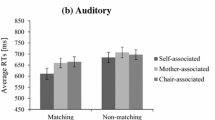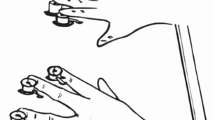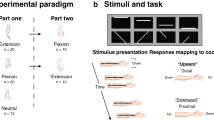Abstract
Object recognition through tactile perception involves two elements: the shape of the object (macrogeometric properties) and the material of the object (microgeometric properties). Here we sought to determine the characteristics of microgeometric tactile representations regarding object recognition through tactile perception. Participants were directed to recognize objects with different surface materials using either tactile information or visual information. With a quantitative analysis of the cognitive process regarding object recognition, Experiment 1 confirmed the same eight concepts (composed of rules defining distinct cognitive processes) commonly generated in both tactile and visual perceptions to accomplish the task, although an additional concept was generated during the visual task. Experiment 2 focused only on tactile perception. Three tactile objects with different surface materials (plastic, cloth and sandpaper) were used for the object recognition task. The participants answered a questionnaire regarding the process leading to their answers (which was designed based on the results obtained in Experiment 1) and to provide ratings on the vividness, familiarity and affective valence. We used these experimental data to investigate whether changes in material attributes (tactile information) change the characteristics of tactile representation. The observation showed that differences in tactile information resulted in differences in cognitive processes, vividness, familiarity and emotionality. These two experiments collectively indicated that microgeometric tactile information contributes to object recognition by recruiting various cognitive processes including episodic memory and emotion, similar to the case of object recognition by visual information.


Similar content being viewed by others
References
Amedi A, Malach R, Hendler T, Peled S, Zohary E (2001) Visuo-haptic object-related activation in the ventral visual pathway. Nat Neurosci 4:324–330. https://doi.org/10.1038/85201
Amedi A, Jacobson G, Hendler T, Malach R, Zohary E (2002) Convergence of visual and tactile shape processing in the human lateral occipital complex. Cereb Cortex 12:1202–1212. https://doi.org/10.1093/cercor/12.11.1202
Anderson JR, Bothell D, Lebiere C, Matessa M (1998) An integrated theory of list memory. J Mem Lang 38:341–380. https://doi.org/10.1006/jmla.1997.2553
Axelrod V, Rees G, Bar M (2017) The default network and the combination of cognitive processes that mediate self-generated thought. Nat Hum Behav 1:896–910. https://doi.org/10.1038/s41562-017-0244-9
Ballesteros S, Reales JM, Manga D (1999) Implicit and explicit memory for familiar and novel objects presented to touch. Psicothema 11:785–800
Baumgartner E, Wiebel CB, Gegenfurtner KR (2013) Visual and haptic representations of material properties. Multisens Res 26:429–455. https://doi.org/10.1163/22134808-00002429
Bonda E, Petrides M, Evans A (1996) Neural systems for tactual memories. J Neurophysiol 75:1730–1737
Chapman LJ, Chapman JP (1987) The measurement of handedness. Brain Cogn 6:175–183. https://doi.org/10.1016/0278-2626(87)90118-7
Chappell M, Humphreys MS (1994) An auto-associative neural network for sparse representations: analysis and application to models of recognition and cued recall. Psychol Rev 101:103–128. https://doi.org/10.1016/j.neuropsychologia.2006.08.013
Collins AM, Loftus EF (1975) A spreading-activation theory of semantic processing. Psychol Rev 82:407–428. https://doi.org/10.1037/0033-295X.82.6.407
Collins AM, Quillian MR (1969) Retrieval time from semantic memory. J Verbal Learn Verbal Behav 8:240–247. https://doi.org/10.1016/S0022-5371(69)80069-1
Connor CE, Hsiao SS, Phillips JR, Johnson KO (1990) Tactile roughness: neural codes that account for psychophysical magnitude estimates. J Neurosci 10:3823–3836
Conway MA, Pleydell-Pearce CW (2000) The construction of autobiographical memories in the self-memory system. Psychol Rev 107:261–288. https://doi.org/10.1037/0033-295X.107.2.261
Craig AD (2002) How do you feel? Interoception: the sense of the physiological condition of the body. Nat Rev Neurosci 3:655–666. https://doi.org/10.1038/nrn894
DeLeon J, Gottesman RF, Kleinman JT, Newhart M, Davis C, Heidler-Gary J, Lee A, Hillis AE (2007) Neural regions essential for distinct cognitive processes underlying picture naming. Brain 130:1408–1422. https://doi.org/10.1093/brain/awm011
Easton RD, Greene AJ, Srinivas K (1997a) Transfer between vision and haptics: memory for 2-D patterns and 3-D objects. Psychon Bull Rev 4:403–410. https://doi.org/10.3758/BF03210801
Easton RD, Srinivas K, Greene AJ (1997b) Do vision and haptics share common representations? Implicit and explicit memory within and between modalities. J Exp Psychol Learn Mem Cogn 23:153–163. https://doi.org/10.1037/0278-7393.23.1.153
Endo K, Miyasaka M, Makishita H, Yanagisawa N, Sugishita M (1992) Tactile agnosia and tactile aphasia: symptomatological and anatomical differences. Cortex 28:445–469. https://doi.org/10.1016/S0010-9452(13)80154-2
Gallace A, Spence C (2009) The cognitive and neural correlates of tactile memory. Psychol Bull 135:380–406. https://doi.org/10.1037/a0015325
Gibson EJ (1969) Principles of perceptual learning and development. Appleton-Century Crofts, New York
Goodale MA, Milner AD (1992) Separate visual pathways for perception and action. Trends Neurosci 15:20–25. https://doi.org/10.1016/0166-2236(92)90344-8
Ho HN, Jones LA (2006) Contribution of thermal cues to material discrimination and localization. Atten Percept Psychophys 68:118–128. https://doi.org/10.3758/BF03193662
Hollins M, Bensmaïa SJ, Washburn M (2001) Vibrotactile adaptation impairs discrimination of fine, but not coarse, textures. Somatosens Mot Res 18:253–262. https://doi.org/10.1080/01421590120089640
James TW, Humphrey GK, Gati JS, Servos P, Menon RS, Goodale MA (2002) Haptic study of three-dimensional objects activates extrastriate visual areas. Neuropsychologia 40:1706–1714. https://doi.org/10.1016/S0028-3932(02)00017-9
Katz D (1989) The world of touch. (Translated by Krueger LE) Erlbaum, Hillsdale NJ (Original work published in 1925)
Kinoshita Y (2003) Modified grounded theory approach. Kobundo, Tokyo (in Japanese)
Kitada R, Hashimoto T, Kochiyama T, Kito T, Okada T, Matsumura M, Lederman SJ, Sadato N (2005) Tactile estimation of the roughness of gratings yields a graded response in the human brain: an fMRI study. Neuroimage 25:90–100. https://doi.org/10.1016/j.neuroimage.2004.11.026
Klatzky RL, Lederman SJ (1987) The intelligent hand. In: Bower GH (ed) The psychology of learning and motivation: advances in research and theory, vol 21. Academic Press, New York, pp 121–151
Klatzky RL, Lederman SJ (2008) Object recognition by touch. In: Rieser JJ, Ashmead DH, Ebner FF, Corn AL (eds) Blindness and brain plasticity in navigation and object perception. Taylor & Francis, New York, pp 185–207
Klatzky RL, Lederman SJ, Metzger VA (1985) Identifying objects by touch: an “expert system”. Percept Psychophys 37:299–302. https://doi.org/10.3758/BF03211351
Klatzky RL, Lederman SJ, Matula DE (1991) Imagined haptic exploration in judgments of object properties. J Exp Psychol Learn Mem Cogn 17:314–322. https://doi.org/10.1037/0278-7393.17.2.314
Klatzky RL, Lederman SJ, Matula DE (1993) Haptic exploration in the presence of vision. J Exp Psychol Hum Percept Perform 19:726–743. https://doi.org/10.1037/0096-1523.19.4.726
Lederman SJ, Klatzky RL (1997) Relative availability of surface and object properties during early haptic processing. J Exp Psychol Hum Percept Perform 23:1680–1707. https://doi.org/10.1037/0096-1523.23.6.1680
Lederman SJ, Klatzky RL, Chataway C, Summers CD (1990) Visual mediation and the haptic recognition of two-dimensional pictures of common objects. Percept Psychophys 47:54–64. https://doi.org/10.3758/BF03208164
Lederman SJ, Summers C, Klatzky RL (1996) Cognitive salience of haptic object properties: role of modality-encoding bias. Perception 25:983–998. https://doi.org/10.1068/p250983
Loomis JM, Lederman SJ (1986) Tactual perception. In: Boff KR, Kaufman L, Thomas JP (eds) Handbook of perception and human performance, vol 2. Wiley, New York, pp 1–41
Miyaoka T, Mano T, Ohka M (1999) Mechanisms of fine-surface-texture discrimination in human tactile sensation. J Acoust Soc Am 105:2485–2492. https://doi.org/10.1121/1.426852
Newman SD, Klatzky RL, Lederman SJ, Just MA (2005) Imagining material versus geometric properties of objects: an fMRI study. Brain Res Cogn Brain Res 23:235–246. https://doi.org/10.1016/j.cogbrainres.2004.10.020
Raaijmakers JGW, Shiffrin RM (1981) Search of associative memory. Psychol Rev 88:93–134. https://doi.org/10.1037/0033-295X.88.2.93
Ramachandran VS, Brang D (2008) Tactile-emotion synesthesia. Neurocase 14:390–399. https://doi.org/10.1080/13554790802363746
Reales JM, Ballesteros S (1999) Implicit and explicit memory for visual and haptic objects: cross-modal priming depends on structural descriptions. J Exp Psychol Learn Mem Cogn 25:644–663. https://doi.org/10.1037/0278-7393.25.3.644
Roland PE, O’Sullivan B, Kawashima R (1998) Shape and roughness activate different somatosensory areas in the human brain. Proc Natl Acad Sci USA 95:3295–3300
Sathian K (2005) Visual cortical activity during tactile perception in the sighted and the visually deprived. Dev Psychobiol 46:279–286. https://doi.org/10.1002/dev.20056
Sathian K, Zangaladze A (2001) Feeling with the mind’s eye: the role of visual imagery in tactile perception. Optom Vis Sci 78:276–281
Sathian K, Zangaladze A (2002) Feeling with the mind’s eye: contribution of visual cortex to tactile perception. Behav Brain Res 135:127–132. https://doi.org/10.1016/S0166-4328(02)00141-9
Sathian K, Zangaladze A, Hoffman JM, Grafton ST (1997) Feeling with the mind’s eye. NeuroReport 8:3877–3881
Seitz JA, Beilin H (1987) The development of comprehension of physiognomic metaphor in photographs. Br J Dev Psychol 5:321–331. https://doi.org/10.1111/j.2044-835X.1987.tb01068.x
Smith AM, Basile G, Theriault-Groom J, Fortier-Poisson P, Campion G, Hayward V (2010) Roughness of simulated surfaces examined with a haptic tool: effects of spatial period, friction, and resistance amplitude. Exp Brain Res 202:33–43. https://doi.org/10.1007/s00221-009-2105-x
Srinivasan MA, LaMotte RH (1995) Tactual discrimination of softness. J Neurophysiol 73:88–101
Stilla R, Sathian K (2008) Selective visuo-haptic processing of shape and texture. Hum Brain Mapp 29:1123–1138. https://doi.org/10.1002/hbm.20456
Tulving E, Donaldson W (1972) Organization of memory. Academic Press, London
Whitaker TA, Simões-Franklin C, Newell FN (2008) Vision and touch: independent or integrated systems for the perception of texture? Brain Res 1242:59–72. https://doi.org/10.1016/j.brainres.2008.05.037
Zhang M, Weisser VD, Stilla R, Prather SC, Sathian K (2004) Multisensory cortical processing of object shape and its relation to mental imagery. Cogn Affect Behav Neurosci 4:251–259. https://doi.org/10.3758/CABN.4.2.251
Acknowledgements
We thank Dr. Fumio Yagi for his invaluable feedback and support.
Author information
Authors and Affiliations
Corresponding author
Ethics declarations
Conflict of interest
The authors declare that they have no conflict of interest.
Ethical standard
All procedures performed in studies involving human participants were in accordance with the ethical standards of the institutional and/or national research committee and with the 1964 Declaration of Helsinki and its later amendments or comparable ethical standards. The experiment reported here was approved by the Ethical Committee of Kochi School of Allied Health and Medical Professions.
Informed consent
Informed consent was obtained from all individual participants included in the study.
Rights and permissions
About this article
Cite this article
Yasaka, K., Mori, T., Yamaguchi, M. et al. Representations of microgeometric tactile information during object recognition. Cogn Process 20, 19–30 (2019). https://doi.org/10.1007/s10339-018-0892-3
Received:
Accepted:
Published:
Issue Date:
DOI: https://doi.org/10.1007/s10339-018-0892-3




